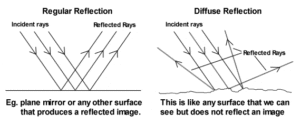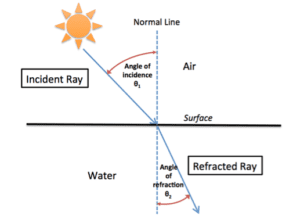When light encounters the interface between two different media, such as air and water or air and glass, its behavior can be described by several principles, including reflection, refraction, and transmission. Let’s discuss each of these behaviors:
Reflection of light
Reflection occurs when light “bounces” off the interface between two media. The angle at which the light ray approaches the interface is called the incident angle (θi), and the angle at which it reflects is called the reflected angle (θr).

According to the law of reflection, the incident angle is equal to the reflected angle, and both angles are measured with respect to the normal, which is an imaginary line perpendicular to the interface. The reflected light ray remains in the same medium as the incident ray.
Refraction of light
Refraction is the bending of light as it passes from one medium to another with a different optical density. When light enters a new medium, its speed changes, causing the light ray to change direction.

The incident angle (θi) and the angle of refraction (θt) are related by Snell’s law, which states that the ratio of the sines of the angles is equal to the ratio of the velocities of light in the two media: $$\frac{\sin(\theta i)}{\sin(\theta t)} = \frac{v_1}{v_2}$$
The refracted ray can either bend towards the normal (if the medium it enters has a higher optical density) or away from the normal (if the medium it enters has a lower optical density).
Transmission of light
Transmission occurs when light passes through the interface and enters the second medium. The transmitted light ray is a combination of the reflected and refracted rays. The relative intensities of the reflected and refracted rays depend on factors such as the angle of incidence and the optical properties of the media involved.

The behavior of light at the interface of two media depends on the properties of the media, such as their refractive indices, which describe how much the speed of light is reduced in the medium compared to a vacuum. The refractive index determines the extent of bending and reflection that occur at the interface.
Here, it is important to note that these principles assume an idealized scenario without factors like absorption, scattering, or surface roughness, which can also affect the behavior of light at the interface between two media.
Frequently Asked Questions (FAQs)
What is the difference between reflection and refraction at the interface of two media?
Reflection is the bouncing back of light when it encounters the interface, while refraction is the bending of light as it passes from one medium to another.
How does the incident angle affect the amount of light reflected and refracted at the interface?
The incident angle affects the amount of light reflected and refracted at the interface. As the incident angle increases, the amount of light reflected also increases, while the amount of light refracted decreases.
What is Snell’s law, and how is it used to determine the angle of refraction?
Snell’s law relates the incident angle and the angle of refraction at the interface of two media. It states that the ratio of the sines of the incident and refracted angles is equal to the ratio of the velocities of light in the two media. Mathematically, it can be represented as sin(θi) / sin(θt) = v1 / v2, where θi is the incident angle, θt is the angle of refraction, v1 is the velocity of light in the first medium, and v2 is the velocity of light in the second medium.
How does the refractive index of a medium affect the behavior of light at the interface?
The refractive index of a medium determines how much the speed of light changes when it enters that medium. It affects the angle of refraction and the amount of light reflected at the interface. A higher refractive index leads to a larger change in direction (bending) of the light ray and a greater amount of light reflected.
Can you provide an example of how the behavior of light changes when it passes from air to water or from air to glass?
When light passes from air to water, it undergoes refraction. The incident ray bends toward the normal because water has a higher refractive index than air. On the other hand, when light passes from air to glass, it also undergoes refraction, but the amount of bending is greater as glass has a higher refractive index than air. Both cases involve partial reflection and partial transmission of the incident light at the interface.
Stay tuned with Laws Of Nature for more useful and interesting content.








